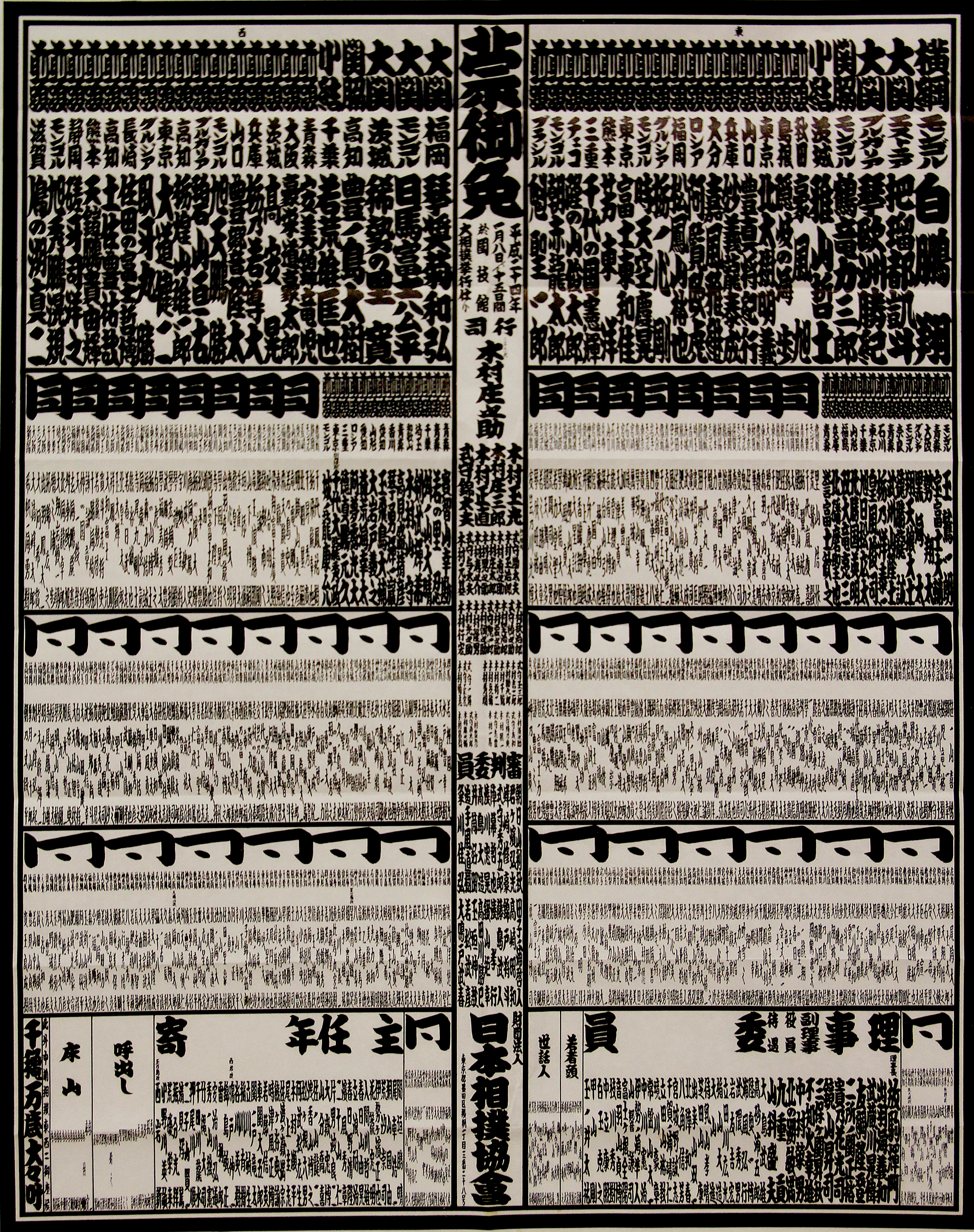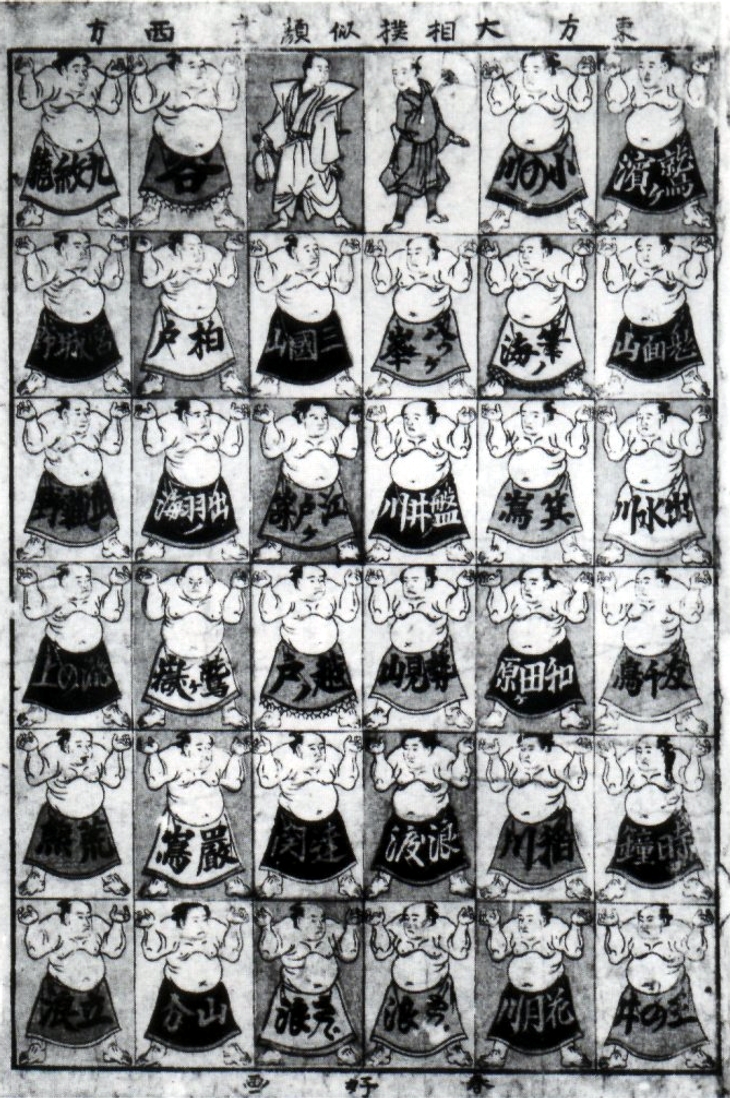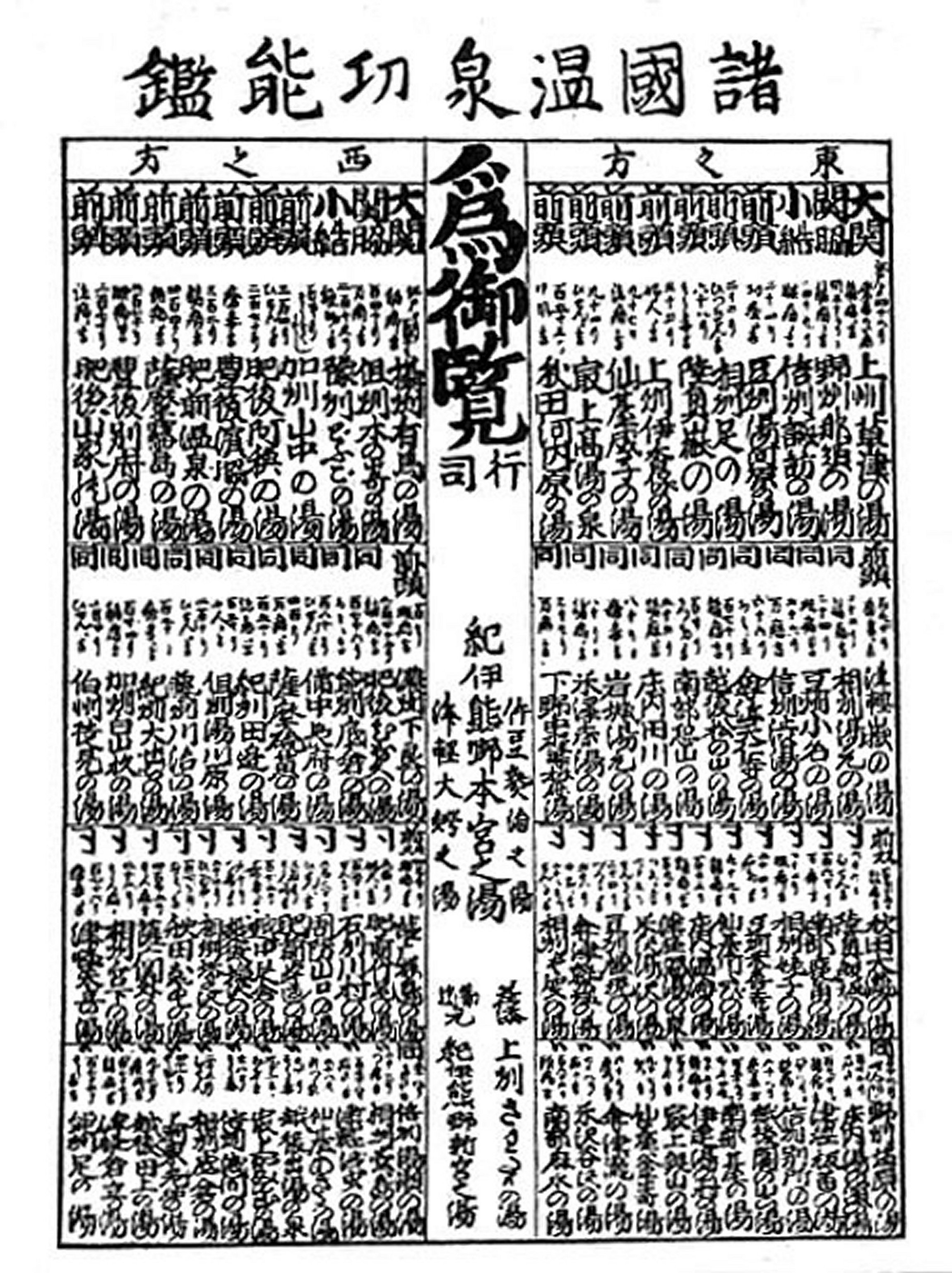Banzuke on:
[Wikipedia]
[Google]
[Amazon]
 A , officially called is a document listing the rankings of professional
A , officially called is a document listing the rankings of professional

 The rankings on the ''banzuke'' are decided by an assembly composed of 20 sumo judges and three supervisors who gather a few days after each official tournament. The assembly assigns ranks to over 600 wrestlers in six divisions based on their performance in the previous tournament. There are no precise rules for assigning rank, but the general rule is that a wrestler who achieved '' kachi-koshi'' (a majority of wins) will be raised in the rankings and a wrestler with a ''
The rankings on the ''banzuke'' are decided by an assembly composed of 20 sumo judges and three supervisors who gather a few days after each official tournament. The assembly assigns ranks to over 600 wrestlers in six divisions based on their performance in the previous tournament. There are no precise rules for assigning rank, but the general rule is that a wrestler who achieved '' kachi-koshi'' (a majority of wins) will be raised in the rankings and a wrestler with a ''
Professional rankings: The Banzuke
SC Group Sumo terminology Sport in Japan Japanese words and phrases
 A , officially called is a document listing the rankings of professional
A , officially called is a document listing the rankings of professional sumo
is a form of competitive full-contact wrestling where a ''rikishi'' (wrestler) attempts to force his opponent out of a circular ring (''dohyō'') or into touching the ground with any body part other than the soles of his feet (usually by th ...
wrestlers published before each official tournament ('' honbasho''). The term can also refer to the rankings themselves. The document is normally released about two weeks before the tournament begins.
On the ''banzuke'', wrestlers are divided into East, which is printed on the right, and West, which is printed on the left. Each wrestler's full ''shikona
A is a sumo wrestler's ring name. The tradition of ring names in sumo dates back to the Muromachi period and established itself during the Edo period, where they were used as a means to hide the identities of the .
Given by the master to his di ...
'' (ring name), hometown and rank is also listed. The top of the page starts with the highest ranked ''makuuchi
, or , is the top division of Professional sumo divisions, the six divisions of professional sumo. Its size is fixed at 42 wrestlers (''rikishi''), ordered into five ranks according to their ability as defined by their performance in previous ...
'' wrestlers printed in the largest characters, down to the wrestlers in the lowest divisions
Division may refer to:
Mathematics
*Division (mathematics), the inverse of multiplication
* Division algorithm, a method for computing the result of mathematical division Military
*Division (military), a formation typically consisting of 10,000 t ...
which are written in much smaller characters. The names of '' gyōji'' (sumo referees), '' yobidashi'' (ushers/handymen), '' shimpan'' (judges), '' oyakata'' (elders of the Japan Sumo Association
The , officially the ; sometimes abbreviated JSA or NSK, and more usually called Sumo Kyōkai, is the governing body that operates and controls Professional sports, professional sumo wrestling, called , in Japan under the jurisdiction of the Min ...
), and occasionally ''tokoyama
A is a traditional Japanese hairdresser specializing in the theatrical arts (kabuki and ) and Sumo#Professional sumo, professional sumo. The trade is the result of a slow evolution from the traditional Japanese barbers of the Edo period, some ...
'' (hairdressers) are also listed.
While not as old as sumo itself, the form and production of this document can be traced as far back as 1761, and has been a defining component of sumo for centuries. As is the traditional Japanese style, a ''banzuke'' is meant to be read right to left, top to bottom. It is considered a collector's item by sumo fans.
''Banzuke'' preparation

 The rankings on the ''banzuke'' are decided by an assembly composed of 20 sumo judges and three supervisors who gather a few days after each official tournament. The assembly assigns ranks to over 600 wrestlers in six divisions based on their performance in the previous tournament. There are no precise rules for assigning rank, but the general rule is that a wrestler who achieved '' kachi-koshi'' (a majority of wins) will be raised in the rankings and a wrestler with a ''
The rankings on the ''banzuke'' are decided by an assembly composed of 20 sumo judges and three supervisors who gather a few days after each official tournament. The assembly assigns ranks to over 600 wrestlers in six divisions based on their performance in the previous tournament. There are no precise rules for assigning rank, but the general rule is that a wrestler who achieved '' kachi-koshi'' (a majority of wins) will be raised in the rankings and a wrestler with a ''make-koshi
The following words are terms used in sumo wrestling in Japan.
A
B
C
D
E
F
G
H
...
'' (a majority of losses) will be lowered in the rankings. The degree of a wrestler's success or failure will help give the assembly a benchmark for figuring how far he rises or falls in the rankings.
High-ranking '' gyōji'' then take on the laborious task of copying down the new rankings on a traditional Japanese paper roll called a ''maki''. They carefully write down the ''kanji
are logographic Chinese characters, adapted from Chinese family of scripts, Chinese script, used in the writing of Japanese language, Japanese. They were made a major part of the Japanese writing system during the time of Old Japanese and are ...
'' characters of each wrestler participating in a tournament in a calligraphy style called sumo ''moji''. The work is very intricate and requires a great deal of skill. It usually takes about a week to complete the document. The ''banzuke'' information is carefully guarded for several weeks before it is released, which is usually on the Monday 13 days before an official tournament begins. The exception is the information about wrestlers who rise from the third division ''makushita'' to the second division ''juryo'': their names become known immediately because they obtain the status of ''sekitori'' and have to make necessary preparations for it. A ''banzuke'' release may also be pushed back if the traditional publishing date falls on a national holiday. Indicates the date of the May 2024 tournament's ''banzuke'' release was on Tuesday 30 April, as Monday 29 April was Shōwa Day
is a public holiday in Japan held on April 29. It honors the birthday of Emperor Shōwa (Hirohito), the reigning emperor from 1926 to 1989. Shō (昭) means "shining" or "bright", and wa (和) means "peace", signifying the "enlightened peace" ...
.
The ''banzuke'' is printed at a greatly reduced size on sheets of paper (58 cm x 44 cm) and copies are distributed by the Japan Sumo Association
The , officially the ; sometimes abbreviated JSA or NSK, and more usually called Sumo Kyōkai, is the governing body that operates and controls Professional sports, professional sumo wrestling, called , in Japan under the jurisdiction of the Min ...
. Sumo stables
A stable is a building in which working animals are kept, especially horses or oxen. The building is usually divided into stalls, and may include storage for equipment and feed.
Styles
There are many different types of stables in use tod ...
buy a large quantity of them to give to their sponsors. Tea houses in the Tokyo
Tokyo, officially the Tokyo Metropolis, is the capital of Japan, capital and List of cities in Japan, most populous city in Japan. With a population of over 14 million in the city proper in 2023, it is List of largest cities, one of the most ...
sumo venue Kokugikan also buy them to give out to their patrons. They are also available for purchase for a small fee at tournament sites.
See also
*Glossary of sumo terms
The following words are terms used in sumo wrestling in Japan.
A
B
C
D
E
F
G
H
...
* List of active sumo wrestlers
References
{{reflistExternal links
Professional rankings: The Banzuke
SC Group Sumo terminology Sport in Japan Japanese words and phrases